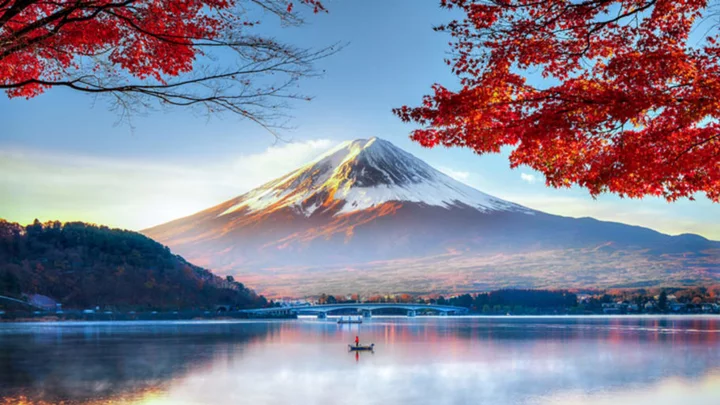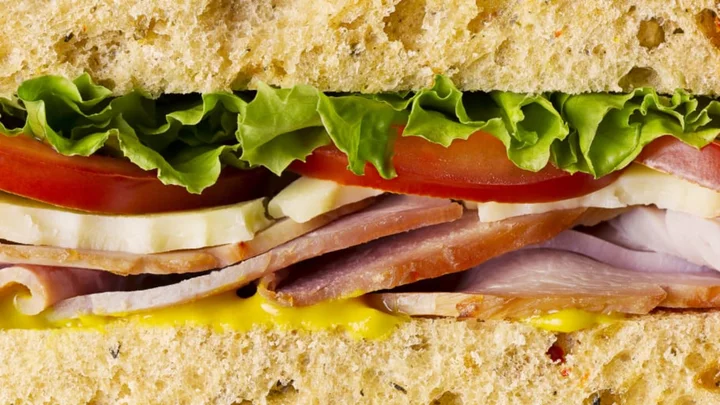Long-held stereotypes about food, samurai spirit, and an unyielding work ethic are all tropes that have contributed to the exoticizing of Japan in Western minds. During World War II, that went a step further, to outright demonization, with demeaning caricatures and even concentration camps for Japanese Americans.
Today, we still tend to think of Japan as tech-obsessed, crowded, and home to some truly wild game shows. Let’s break down some illusions about this very influential, and often misunderstood, country, adapted from an episode of Misconceptions on YouTube.
1. Misconception: Japanese people slurp their noodles loudly on purpose.
Misophonia is a condition in which people can be annoyed by common sounds—a screaming baby, for example, or someone smacking their food, or perhaps a baby smacking their food while also screaming. If you have misophonia, you might have second thoughts about a trip to Japan, where residents reportedly slurp loudly and purposefully during mealtimes to show their appreciation for delicious noodle bowls. Some people believe the country is practically a symphony of slurping and masticating, with restaurants full of patrons making as much noise as possible as a way of complimenting the chef.
In fact, the only thing rude about this scenario is assuming it exists at all. While it’s true that Japanese people do slurp without feeling self-conscious, it’s not expected or considered impolite to refrain from doing so. Slurping is done to help draw in air to cool down hot noodle dishes and experience a retronasal smell, or sniffing through your mouth and taste buds. Slurping also keeps more of the broth on the noodle. It’s more of a food strategy to maximize taste than a cultural custom. You don’t have to do it and no one will throw you a dirty look for skipping it. Some Japanese people even consider slurping too loudly a form of noodle harassment, where foreigners can feel intimidated or even unwelcome by the volume of slurping.
2. Misconception: Japan is on the cutting edge of tech.
Since the days of the Sony Walkman in the 1980s, Americans have classified Japanese people as being a culture obsessed with the latest and greatest gadgets. Electronics marketing helped reinforce that point. Sony televisions were pricey; most household devices, like VCRs and DVD players, had Japanese origins. We bought Panasonic phones, listened to Duran Duran on Sanyo audio equipment, and sat in front of Hitachi big screens. It all gave way to a sense that a typical Japanese household must be living in the future, with robot butlers and toilets that talk to you.
While there are undoubtedly gadget-obsessed residents just like anywhere else, on the whole the Japan tech scene isn’t necessarily light years ahead of here or anywhere. And in certain areas, it’s actually lagging a bit behind. For example, plenty of Japanese businesses still use fax machines, where sending and receiving messages on paper is a common form of communication.
What about streaming services? In the States, about 85 percent of consumers have at least one streaming service like Netflix. In Japan, it’s only about 46 percent.
And, much like the U.S. preoccupation with collecting vintage records, Japan has a bustling retro music scene—but it’s for cassette tapes. In 2021, Vice reported that Gen Z in Japan has become invested in the analog format, both for library titles and new music. Enthusiasts like making their own mix tapes and taking cassette players to the beach. Tape manufacturer Maxell still makes 8 million of them annually.
According to the BBC, things like handwritten faxes, tapes, and outdated software are likely a product of small independent businesses making up most of the commercial landscape in the country. Without major corporations mandating high-tech and ultra-efficient advancements, many people in Japan are content to keep things simple at work and at home.
One area where Japan may deserve its future-forward reputation is in their toilets. The Toto brand is immensely popular there, with their toilets greeting users and offering an array of amenities, from bidets to music that helps mask the sounds of passage.
3. Misconception: Everyone eats sushi.
Raw fish wrapped in a roll—what could go wrong? If you buy it at a gas station, a lot of things. Things that may tax your Toto toilet. But an even bigger lapse in judgment is in assuming Japanese people are obsessed with sushi, or even that it originated there.
While it’s absolutely true that Japan popularized sushi, arguably the first mention of it can be found as far back as 1600 years ago in China and Thailand, where fish was placed in rice for fermentation. Acid from the rice along with salt helps to kill bacteria in the fish and allows for it to be kept longer, a necessary life hack in a world without refrigerators. Then, in the 1820s, a man named Hanaya Yohei marketed just-caught or marinated fish on top of hand-squeezed rice, introducing a more modern concept of sushi to Japan and eventually the globe.
You might say sushi is to Japan what hamburgers are to America. But we don’t eat hamburgers every day. In Japan, sushi is not an everyday part of diets in the way, say, oatmeal or eggs might be for Americans. It’s more of a special-occasion dish, something ordered for events like birthdays. What’s more, what we think of sushi isn’t even what you’d typically find in Japan. Popular sushi dishes in the U.S., like spicy tuna, aren’t common there. The same goes for avocado or other extras like mayo.
You can also stop practicing your chopsticks game. Most people in Japan eat sushi with their hands, not with any utensils, although it’s certainly socially acceptable to break out the sticks.
So if they’re not digging into the spicy tuna, what is a common diet in Japan? Like anywhere else, that can be a little difficult to generalize. You can get as much junk food as you like there. But when sticking to a healthy diet, Japanese people tend to consume soybean products, fresh fish and meat, rice, fruits, vegetables, and yes, green tea.
One last misconception about sushi. It doesn’t necessarily mean raw fish. Sushi translates to “it is sour” and refers to the taste. Of course, sushi can contain raw fish, known as sashimi, but it doesn’t have to. Nor does it have to contain rice.
4. Misconception: Japan is super expensive.
Listen to some of the hype surrounding Tokyo and you can quickly get the idea that it can be an impossibly expensive place to live, or even visit—like New York City or Singapore.
Truth is, the cost of living in Japan isn’t as steep as you might think. While definitely more costly in terms of food, lodging, and entertainment than some countries, Japan is actually less expensive than Switzerland, England, or Australia. If you want to go the ultra-budget route, you can find a hostel in Kyoto for as little as $25 a night. Riding the train or subway runs a few dollars per trip, and you can get excellent meals to slurp for less than $15. Local convenience store box food is as little as $4.
Obviously, you can spend as much as you like on fine dining and five-star hotels, but it’s not wholly necessary to explore the country.
What if you live there? It’s absolutely true Tokyo is among the most expensive cities in the world, but that doesn’t mean you don’t have options. One blogger, Margherita Pitorri, recently estimated a studio apartment in Tokyo can be had for as little as $727 per month. That can go up or down depending on the region of the city you choose, but it’s vastly cheaper than comparable rentals in major U.S. cities. Expenses like utilities and internet are also reasonable.
Overall, Japan is certainly affordable, particularly if you settle down in a more rural community and take advantage of the country’s efficient public transportation system.
Like most anywhere, it depends on what luxuries or amenities you want and which you can do without. It also depends on how close you want to live to the major metropolitan areas, which brings us to our next misconception.
5. Misconception: Japan is crowded.
When the media covers Japan, a lot of focus gets put on population density. Tokyo is the most populous metropolitan area with 37 million residents, and some stories have highlighted the ultimate in tiny living—apartments as small as 95 square feet that are barely functional as anything but a place to sleep. That’s on top of footage of bustling Tokyo intersections. If you go by that, living in Japan must feel like living in an elevator. But is Japan really that teeming with humanity?
While it’s true Tokyo is a hub of work and play, most of Japan isn’t really like that. It would be like saying New York State is impossible to get around because Times Square is so packed. The truth is, the desire to be near major cities like Tokyo, Osaka, or Nagoya has left over half of Japan’s municipalities in danger of being designated as underpopulated. Millions of unoccupied homes sit on the real estate market. According to CNN, the small village of Nagoro has declined from 300 residents just 30, none under the age of 50.
The problem of Tokyo being overpopulated and the rest of Japan being relatively sparse has grown so severe that Japan’s government is offering financial incentives for families to move into more rural areas. Families will get about 1 million yen, or $7,700, for each child if they move.
Nationally, Japan is also facing stagnant population growth. In 2017, for example, there were more deaths than births, with Tokyo residents producing a fertility rate of 1.17. It’s possible that by 2050, Japan’s entire population could fall from 125 million today to under 100 million. Some experts believe career demands, like those seen in and around Tokyo, are partially to blame for fewer people wanting offspring. It’s concerning enough that in the town of Nagi, officials pay couples about 100,000 yen, or $900, to have a child, with another $1300 for having a second child.
So could you feel cramped in Tokyo or another major city? Sure. But on the whole, Japan isn’t overstuffed, and some places even want to bribe residents into reproducing.
6. Misconception: Masks are worn only to avoid getting sick.
While most of the world had a serious societal shock in 2020 when masks became a regular part of the day, Japan didn’t need much adjustment. A strange and even controversial new protocol for Westerners, masking is Japan has been deemed socially acceptable for decades. And while avoiding infectious diseases is part of the reason, there’s a bit more to it than that.
A number of Japanese people don masks to minimize symptoms of hay fever and other allergic reactions to airborne irritants. In fact, use of the masks in the country can be traced back to the 19th century, when miners wore them to reduce their exposure to dust. After the 1918 flu pandemic, they became an everyday accessory for many residents.
Usage picked up considerably in 2011, after the Fukushima nuclear reactor disaster, with some Japanese people believing the masks could prevent inhalation of radioactive debris [PDF] . All of this has contributed to a social acceptance of mask-wearing.
It’s not strictly about health. Sometimes a person will put one on if they don’t feel like wearing make-up, or even to avoid social interactions. And members of the notorious Bosozoku biker gang have been known to wear them to avoid being identified in case they feel like doing crime. So, yes, reducing chances of spreading or catching germs is a factor, but not the sole motivation. They might just be worried about allergies, or robbing an ATM.
7. Misconception: Japanese game shows are weird and dangerous.
Stunts in which contestants play human curling or get wrapped up like mummies are just a couple of the outrageous challenges on Japanese game shows. Some associate Japan’s game shows with outright sadism. But this is another example of taking the most extreme sample and applying it to an entire genre.
According to The Atlantic, Japanese televised game shows began in the 1950s, around the same time as their American counterparts, and were pretty benign, with things like charades getting primetime treatment. Then, in the 1980s, a show called Takeshi’s Castle began airing. The show featured competitors trying to storm a castle while having things tossed at them all while wearing embarrassing costumes. Because Takeshi’s Castle was syndicated around the world, it became synonymous with the entire Japanese game show culture. And in fairness, some producers embraced the conceit, with a series of shows featuring plenty of titillating or humiliating components in the 1990s.
But these shows were largely outliers, even in Japan. They often aired later at night and were far from appointment viewing. There was even a push for new broadcasting standards to tone down their more sexual and extreme content, and by 2000, many of these programs succumbed to the public pressure to get off the air.
In the end, while a lot of seemingly absurd shows have emerged from Japan, they suffer from a kind of selection bias. Think of it this way. What if American networks decided to unload game shows like Fear Factor to other countries and nothing else? No Survivor or Bachelor? There’s a good chance international viewers would think American audiences only wanted to watch contestants eat bull testicles and spiders, and we would feel a great national shame.
As for Takeshi’s Castle, it actually came back in 2022 on Amazon Prime.
8. Misconception: Tattoos are banned or illegal.
Our last misconception does have a large element of truth to it. In Japan, it’s common for public establishments like gyms, pools, and bath houses to ban people with visible tattoos. The reason is that body art has often been synonymous with organized crime, or the yakuza. According to anthropologist Margo DeMello, in the 19th century, tattoos were actually banned so only people on the margins of society were getting them—like gangsters. When the ban was lifted in 1948, tattooing “was so far underground that most decent Japanese citizens would not consider becoming tattooed.” In onsen, or hot spring baths, proprietors who wanted to keep yakuza from the premises declared a blanket ban on anyone with a tattoo. It was easier than trying to single out yakuza, which might bring about some unpleasant reprisal.
But this is something that’s been changing, and rapidly. In recent years, a growing number of younger Japanese people have been opting for body art as a means of self-expression. According to The New York Times, the number of citizens with tattoos has nearly doubled since 2014 to 1.4 million today—representing a significant increase in acceptance. In 2020, Japan’s Supreme Court ruled that anyone with proper training could perform tattoo work, instead of strictly medical professionals, which means more tattoo parlors are opening. And more bath houses and onsen are admitting those with tattoos.
Even though there’s still a stigma associated with tattoos, with some employers frowning upon them, aficionados are demanding that Japanese society learn to live with ink. Call it a misconception in progress.
This article was originally published on www.mentalfloss.com as 8 Misconceptions About Japan.









